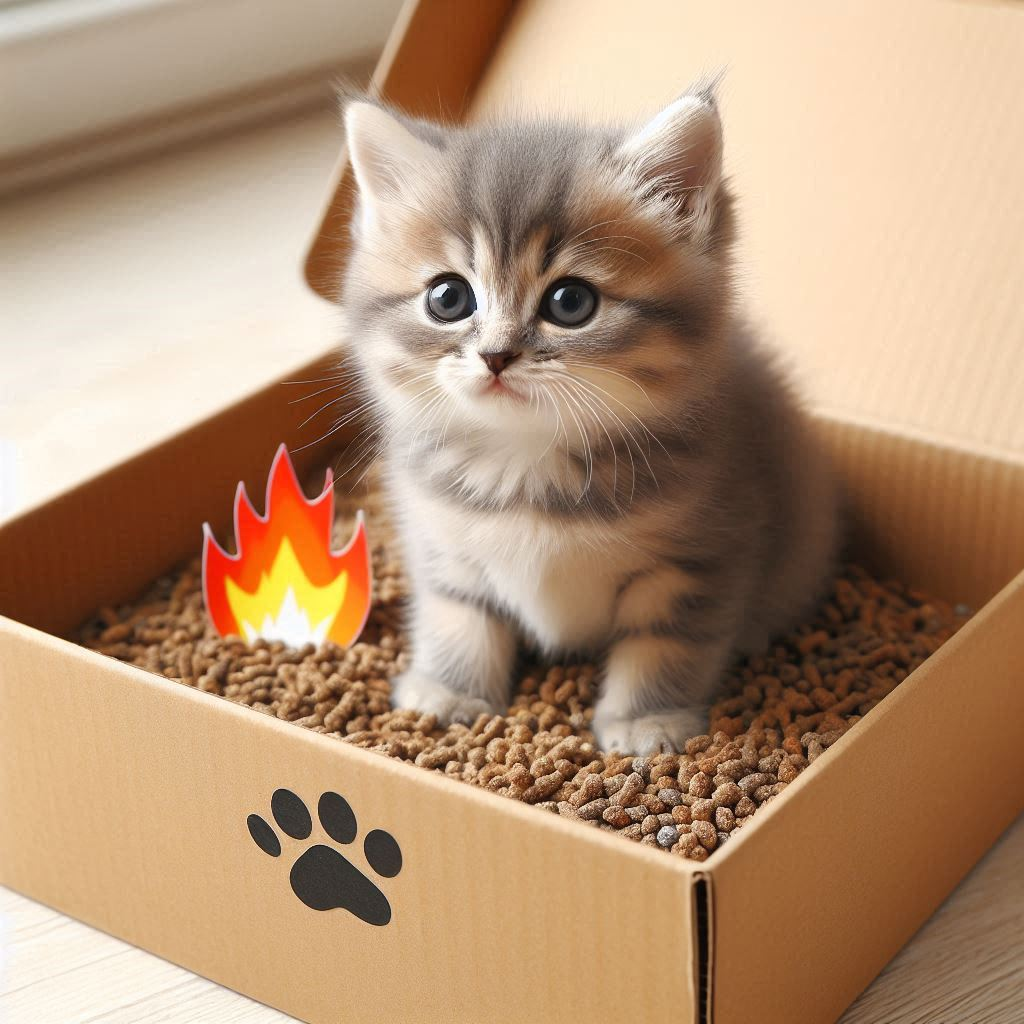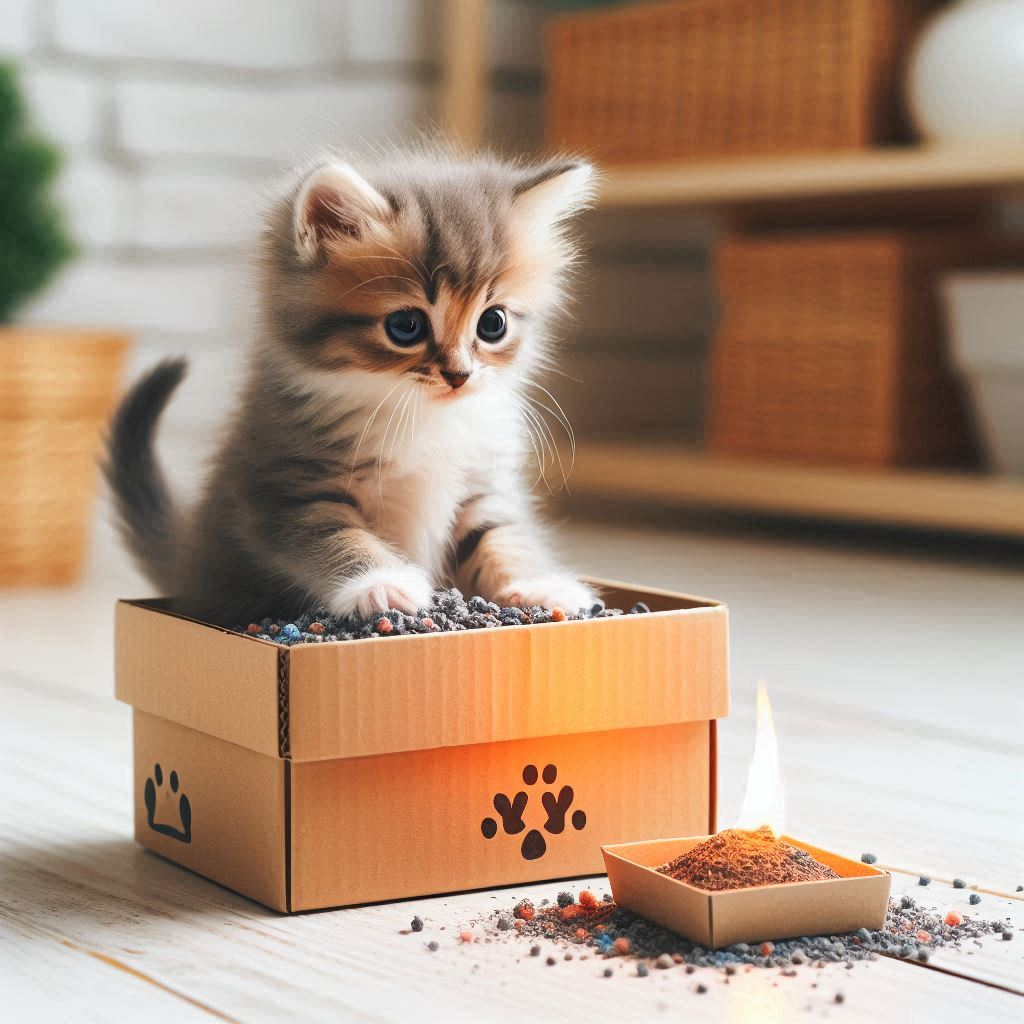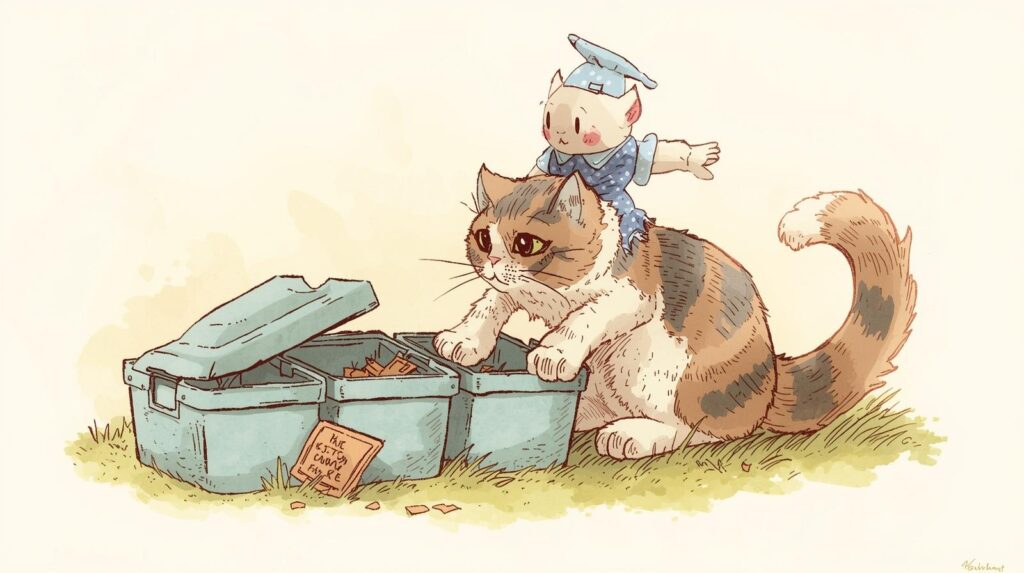Is your cat litter flammable? When it comes to the flammability of cat litter, it’s important to understand that not all types of litter are created equal. While some are completely non-flammable, others may pose a fire risk under certain conditions. This article will delve into the various types of cat litter and their associated fire risks, as well as guide how to prevent fire hazards and keep your household safe.

Is Cat Litter Flammable? A Quick Answer
Yes, cat litter can be flammable, but not all kinds will catch fire. Clay-based litters, which are the most common, are made from bentonite clay and are not flammable under normal conditions. Silica crystal litters are also non-flammable because they are made from silica gel, which doesn’t ignite easily.
On the other hand, plant-based litters such as pine pellets, recycled paper, wheat, corn, or walnut shell litters are flammable because they are organic and can burn when exposed to enough heat, sparks, or open flames. So, while mineral litter like clay and silica is safe from fire hazards, natural and biodegradable litter can burn if placed near heat sources or mixed with hot ashes.
Table of Contents
Types of Cat Litter and Their Flammability
Understanding the different types of cat litter and their flammability is essential for ensuring your home remains safe. Below, we break down the most common types of cat litter and their respective risks:
Clay-Based Litter (Sodium Bentonite)
Clay cat litter, whether clumping or non-clumping, is not flammable. This type of litter is made from bentonite clay, which is an inert mineral that does not burn under normal household conditions. Product safety data sheets (SDS) for clay litter clearly state that it is “not flammable.”
However, while the litter itself will not catch fire, it can still pose a hazard if mixed with external ignition sources. For example, tossing hot fireplace ashes, lit cigarettes, or burning debris into a trash bag that contains clay litter can still start a fire because of the external heat, not the clay itself.
Also Read: Ran Out of Cat Litter? Here’s What You Can Use Instead
Sodium bentonite in clay litter is sometimes used as a fire suppressant. Some people have even been known to sprinkle it over small kitchen fires to control the flames. This makes clay-based litter one of the safest choices in terms of fire safety.
Silica Gel Litter
Silica gel litter is another non-flammable option for cat owners. Made from non-reactive materials, silica litter doesn’t catch fire, even when exposed to high heat.
This type of litter absorbs moisture well and is highly fire-resistant, making it a practical and safe choice for households, especially in areas where fire risks might be a concern(Catpicky).
Biodegradable Litter (Corn, Pine, Wheat, Paper)
Biodegradable litter is where flammability becomes more of an issue. Made from organic materials like corn, wheat, pine shavings, and recycled paper, these eco-friendly litters are highly combustible.
Corn and wheat-based litters, in particular, can easily ignite under high temperatures(Cat Litter Expert)(PawsAdviser). Pine litters also pose a fire risk due to the natural oils found in the wood, which are flammable in certain conditions(Catpicky).
Also Read: Ultimate Guide to Litter Training Kittens
Biodegradable litters are often chosen for its environmental benefits, but its potential flammability should not be overlooked. Careful storage and disposal practices are key to reducing the risk of fire with these types of litter.
The #1 Overlooked Fire Risk — Hot Ashes & Embers
One of the biggest fire risks with cat litter has nothing to do with the litter itself but with how it is used for disposal. Fire departments warn that ashes from fireplaces, stoves, or BBQs can stay hot for four or more days, even if they look cool on the surface.
If those ashes are thrown into a litter bin, they can easily ignite any combustible material nearby and start a fire. For safety, you should never dump hot ashes into a trash bag or litter box.
Instead, always use a metal container with a tight-fitting lid, keep it stored outside at least 10 feet away from your home or garage, and wait at least 96 hours before putting the ashes in the trash. Following this simple process greatly reduces the risk of a dangerous fire.
Also read: Can you compost cat litter?
Using Cat Litter to Absorb Fuel & Oil Spills
Cat litter is often recommended for soaking up spills of gasoline, oil, or antifreeze, and it does work well for absorbing liquids. However, the real danger comes afterward, because fuel-soaked litter can give off flammable vapors and ignite if not handled properly.
The safe way to dispose of contaminated litter is to scoop it into a sealed metal container with a lid and keep it away from heat or sparks. After that, follow your local hazardous waste disposal rules rather than tossing it in the regular trash. This prevents both fire hazards and environmental harm.
Storage & Placement Safety Checklist
Proper storage of cat litter is just as important as choosing the right type. Always keep bags or boxes of litter away from heaters, furnaces, and water heaters. Store them in a cool, dry place such as a pantry or garage corner. If you are using a plant-based litter like pine or paper, make sure it is not stored near open flames or high heat sources, since these litters can burn.
Never dispose of ashes or litter in paper or plastic bags, because these can catch fire quickly if embers are present. Also, avoid storing cat litter in a car trunk during extreme summer heat, especially if it is near fuel products or chemicals. Following these simple rules will keep both you and your pets safe.
Fire Hazards and Preventive Measures

Even though certain types of litter like clay and silica gel are generally non-flammable, it’s still important to take preventative measures to minimize any fire risks associated with their use. Here are some tips to keep your household safe:
1. Avoid Heat Sources
Always ensure that litter boxes are placed away from heat sources such as stoves, fireplaces, and heating vents. While clay and silica-based litter may not catch fire, the plastic of litter boxes could melt, and flammable materials from the surroundings could accidentally fall into the litter.
Also Read: Maggots in Cat Litter Boxes: Causes, Prevention, and Solutions
Keeping litter boxes away from open flames or high-heat areas is essential for fire safety.
2. Proper Storage
Storing your cat litter, especially biodegradable types, in a cool, dry place can significantly reduce fire risks. High heat or poor ventilation can increase the likelihood of spontaneous combustion in some natural litters. Ensuring proper storage conditions will help protect your household from potential hazards(Cat Litter Expert).
3. Disposal Caution
When disposing of used cat litter, particularly biodegradable varieties, avoid leaving it in areas exposed to fire risks, such as near grills or fire pits. Organic materials in biodegradable litter can ignite, so it’s essential to be cautious when disposing of them.
Using Cat Litter to Extinguish Fires
Interestingly, certain types of cat litter, particularly clay-based litter, can be used to help extinguish small fires. In situations where a fire might start in the kitchen or on a grill, cat litter can be sprinkled over the flames to help smother them.
It’s worth noting, however, that once the litter becomes grease-soaked, it can become more flammable. Therefore, after using cat litter to extinguish a fire, proper disposal of the grease-soaked litter is critical to preventing any secondary fires.
Managing Fire Risks with Different Cat Litter Types
Given the range of flammability across different types of cat litter, it’s crucial to manage fire risks by following best practices. Whether you’re using clay, silica, or biodegradable litter, adopting a proactive approach can prevent fire-related accidents.
Let’s dive deeper into some more effective measures for minimizing fire hazards.
Regular Cleaning of Litter Boxes
Frequent cleaning of your cat’s litter box not only helps maintain hygiene but also reduces potential fire risks. Accumulated litter, especially biodegradable types, can sometimes become a fire hazard if left in place for too long.
Biodegradable litter like corn, wheat, and pine may break down and generate heat under certain conditions, which can lead to combustion. Cleaning the box frequently and replacing the litter reduces the chance of heat build-up.
Monitor for Moisture Build-up
In humid environments, certain litters, particularly organic ones, can absorb excess moisture, leading to mold or heat build-up. If you’re using biodegradable litter, keep an eye on the level of moisture in both the litter box and where the litter is stored.
Ensure you use well-ventilated areas for storage to avoid any risks associated with moisture retention. Silica-based litters are moisture-absorbent but do not pose a fire risk due to their non-flammable properties.
Alternative Litter Box Materials
When considering fire safety, the material of the litter box itself can play a role. Most litter boxes are made from plastic, which, although durable, can melt if exposed to high heat or open flames. If you’re particularly concerned about fire risks, exploring alternative litter box materials may be a wise choice.
Metal Litter Boxes
Metal litter boxes, though less common, offer a fire-resistant alternative to traditional plastic boxes. Metal is non-flammable, so it will not catch fire or melt if exposed to heat. However, you’ll need to ensure the metal surface is smooth to prevent discomfort for your cat. Stainless steel is an excellent option, as it’s durable, easy to clean, and heat-resistant.
Ceramic or Clay Litter Boxes
Some eco-conscious pet owners have turned to ceramic or clay litter boxes. These materials are also non-flammable and offer a sturdy, heat-resistant solution. However, ceramic and clay boxes are often more fragile than metal or plastic, so extra care is needed to prevent breakage. That said, if fire safety is a concern, using such fire-resistant materials might bring peace of mind.
Electrical Appliances and Cat Litter: A Hidden Danger?
Another often overlooked fire hazard in homes with cats is the proximity of litter boxes to electrical appliances. It may seem like a harmless decision to place the litter box next to your washing machine, dryer, or space heater, but this setup can be dangerous.
Avoiding Electric Sparks
Electrical appliances can sometimes emit sparks, especially if they are old or malfunctioning. While clay or silica-based litter won’t ignite easily, biodegradable litters like corn, wheat, or pine are far more susceptible to catching fire from a stray spark. Even a small spark in the wrong spot could lead to a catastrophic situation if it lands in the litter box or on nearby litter. Keeping litter boxes far away from appliances reduces this risk.
Extension Cords and Power Strips
Be cautious if you use extension cords or power strips near your cat’s litter area. Any loose or frayed cords could create sparks. A spark or even overheating could ignite combustible materials, especially if you’re using flammable biodegradable litter. Routinely checking electrical cords for damage is a good practice, as is ensuring they are positioned well away from the litter box.
Additional Safety Tips for Pet Owners
When it comes to ensuring that your household remains safe from fire hazards related to cat litter, a few more proactive steps can help reduce the risks:
1. Use Flame-Resistant Storage Containers
If you’re using biodegradable litter, consider storing it in flame-resistant containers. While biodegradable litter types like corn, wheat, or pine may be more likely to ignite, storing them in secure, non-flammable containers can help prevent fires. Metal storage containers with tight-fitting lids are an excellent option.
2. Install Smoke Alarms in Litter Box Areas
Most homes have smoke detectors in common areas such as kitchens and living rooms, but it can also be helpful to install one near your cat’s litter box. This is especially important if the litter box is in a laundry room or bathroom with electrical appliances. Early detection of smoke can save lives, and placing alarms in strategic areas helps ensure a timely response in case of fire.
3. Consider Fire-Retardant Litter Box Mats
Many pet owners place mats under their litter boxes to catch stray litter. Some of these mats, particularly those made from synthetic materials, can be flammable. To further reduce the risk of fire, consider switching to fire-retardant litter box mats. These mats can prevent stray litter from igniting should they come into contact with heat sources or sparks.
Fireproofing Your Home with Pets
Even if you take every precaution, accidents can still happen. Having a fire safety plan in place is critical for pet owners. Here’s how you can ensure that both you and your pets stay safe:
Create a Fire Escape Plan
Just as you would with human family members, it’s important to have a fire escape plan that includes your pets. Identify safe exits and plan where your pets will go in the event of a fire. For example, keep carriers near exits so that you can quickly evacuate your pets.
Practice Fire Drills with Your Pets
Regularly practicing fire drills with your family, including your pets, can help ensure everyone knows what to do in case of an emergency. Training your cat to enter a carrier quickly in response to a specific cue can save precious time during an emergency.
Fireproofing Your Home
Consider fireproofing your home by installing fire-retardant curtains, rugs, and other furnishings. Keep flammable materials like cleaning supplies and pet litter away from open flames or electrical outlets.
Conclusion: Keeping Your Home Safe and Pet-Friendly
In summary, the flammability of cat litter is a critical consideration, especially if you’re using biodegradable or organic litter. Clay-based and silica gel litters are the safest options from a fire safety perspective, but even they require thoughtful placement and storage. For those opting for eco-friendly litter, taking the necessary precautions with storage, disposal, and heat sources will help reduce any fire risks.
By following the tips outlined above, regularly cleaning your litter box, and choosing the right litter for your home, you can create a safe, comfortable environment for both you and your cat. And remember, proper fire prevention doesn’t just involve the type of litter you use—it also involves taking steps like checking electrical appliances, using smoke alarms, and practicing fire safety drills.
Incorporating these habits into your daily routine will keep your home and your feline friend safe from unexpected fire hazards.
Myth-Busting FAQs
Can cat litter catch fire on its own?
No, cat litter does not spontaneously ignite on its own. Clay and silica litters will not burn, and while plant-based litters are combustible, they only catch fire when exposed to a heat source such as sparks, flames, or hot ashes
Is Crystal cat litter explosive?
No, crystal litter is not explosive. The myth comes from industrial silica dust, but the large silica gel granules used in cat litter are non-flammable and non-explosive under normal household conditions.
Can I burn used cat litter to dispose of it?
No, burning cat litter is not safe. Clay and silica produce dust and fumes when burned, and plant-based litters release smoke and odor. It is safer to bag and dispose of used litter according to local waste rules.
Does charcoal or activated carbon in litter make it more flammable?
No, the addition of charcoal or carbon for odor control does not make litter more flammable. The fire risk depends on the main material (clay, silica, or plant-based).
Can wet cat litter catch fire?
No, wet litter cannot burn. Moisture actually prevents ignition, so damp litter is not a fire risk. The danger comes only from dry, plant-based litters exposed to flames or sparks.
Can I throw hot ashes into cat litter to cool them down?
No, this is unsafe. Ashes can stay hot for days and ignite the litter or the trash bag. Always use a metal container with a lid and let ashes cool for at least 96 hours before disposal.
Is Biodegradable Litter More Dangerous to Catch Fire?
Biodegradable litter is more flammable than clay or silica-based litter due to the organic materials it contains. However, with proper storage and disposal, they can still be a safe and environmentally friendly option for cat owners.
How Can I Store Cat Litter Safely?
Cat litter, especially biodegradable types, should be stored in a cool, dry place to reduce the risk of fire. Keeping the litter away from heat sources and ensuring good ventilation will further minimize the chances of flammability.
Can I Use Cat Litter to Put Out a Fire?
Yes, clay-based cat litter can be used to smother small fires, particularly in kitchen or grill areas. However, once the litter becomes grease-soaked, it can become more flammable, so proper disposal is important.


